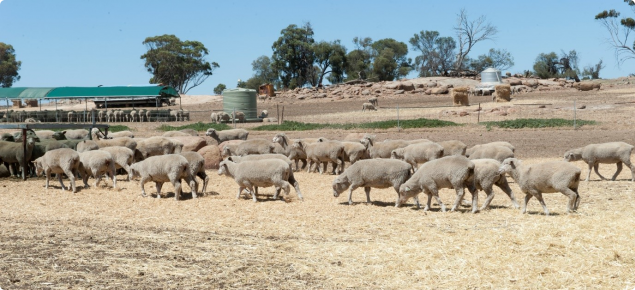When to start supplementary feeding
Ewes start losing condition approximately six weeks after pasture senescence. Once feed on offer (FOO) becomes 1000kg DM/ha or less, animals can’t consume enough to maintain their condition. Thus producers have a six week window following senescence to increase the CS of their ewes using pasture, otherwise it is going to cost money to feed the animals to achieve required CS for joining. Lifetime Ewe recommends ewes are maintained at CS 3 throughout the summer.
Feed budgeting
The easiest and most accurate way to feed budget for summer is using the Lifetime Wool Feed Budget Tables for drought/dry conditions. These tables will help you predict how much to feed if energy is in deficit.
To use the tables you will need to know:
- Average days of pregnancy and number of twin/single pregnancies of the mob
- Average condition score and weight of the mob
- Feed on offer (DM/ha) of the paddock they are going in to
- The metabolisable energy (ME) and dry matter (DM) of the supplementary feed you intend to use in the diet.
Unless ME and DM are provided with the feed you’ve purchased, you need to get your feeds analysed by an accredited laboratory as these values can vary significantly, particularly in forages.
The importance of feed tests
Feed testing can help calculate accurate feed budgets and confirm whether a particular feed source is worth buying. In terms of feed budgeting for sheep in dry conditions the most important values are DM and ME.
Dry matter
One of the most important measurements to know when feeding conserved forage is dry matter. All feeds contain some water, which has no nutritional value. The DM contains all the nutrients in the feed so unless you have an accurate value of DM it is difficult to predict the nutrients your stock are actually receiving. In contrast to forage, most grains predictable at around 90% DM.
Metabolisable energy
In ruminants, ME is the amount of energy available to the animal after urine and gas losses have been accounted and is expressed as MJ/kg DM. Major factors affecting ME in forages include plant maturity at conservation, conservation and storage method, and species. Whilst tabulated values for ME exist, they are only a guide. Oats in particular are highly variable with some oats on the market so low in value that they do not maintain adult sheep and have little value for growing weaners without additional lupins. Feed testing is the only way to accurately measure ME in forage.
Calibrate your feeder and know your bale weights
Bale weight is another measure vital to accurate feed budgeting. It can mean the difference between having enough feed, or running out long before pasture is ready for grazing. Weigh about 10 bales per batch of hay to calculate average bale weight. You will then need to convert this to kg DM.
A little investment in feed tests and weighing bales can lead to big costs/savings
To demonstrate the importance of DM, ME and bale weight consider the following real life example.
Wayne used the Lifetime Wool feed budget tables to calculate that his mob of 500 dry ewes required 9.3 MJ per day to maintain CS 3. They were currently getting 2.3 MJ/d from dry pasture so required an additional 7 MJ/d through supplementary feed.
Wayne had some round bales of oaten hay that he estimated to be around 380kg and about 9 MJ ME/kg DM. He calculated his sheep needed 775g oaten hay/head/day, which equates to 387kg for 500 sheep. He decided to feed them one bale of oaten hay per day.
But, Wayne did not take DM into account, and his estimations of bale weight and ME were just that…estimates. In reality, a feed test would have shown that his hay was 85% DM, only 8 MJ ME/kg DM and weighing the bales would have revealed that the average bale weighed 320kg as fed, which is actually only 272kg DM.
Based on the lower ME and DM of this batch of hay, his mob of ewes were actually receiving only 4.4 MJ/d instead of 7. They needed 438kg DM hay per day, and, because he hadn’t done his measurements, he was only feeding them 272kg DM. This means. By the time Wayne condition scored the mob one month later they’d lost more than 0.2 CS and he needed to buy in extra lupins to regain the weight they’d lost. Luckily, joining was still a few weeks away or he may have found many ewes carrying singles or empty later in the season.
On the other hand, it is just as likely that ME and DM could be underestimated, leading to feeding surplus to requirements. This is costly and your supply of feed may run out before the new season pasture comes in.
At a minimum you should feed test for ME and DM and manually weigh at least 10 bales from each batch of hay to get an average bale weight.
Purchasing supplementary feed
If you need to buy in grain or hay always ask for ME, DM and bale weight (hay/silage only) before committing to a purchase. This will give you negotiating power and help you estimate how many bales or tonnes to buy so you are not caught short of feed at the end of the season.
Additional information
DPIRD has a feed cost calculator to compare the value of different feeds. It can also be used to work out the feed value of a chosen mix of feed in terms of its energy and protein value.
DPIRD’s Supplementary feeding and feed budgeting for sheep webpage also contains valuable information on a wider range of supplementary feeds, feeding methods, frequency and weaner energy requirements.

